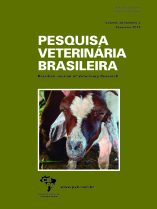 |
|
|
|
Year 2018 - Volume 38, Number 2
|

|
Consecutive outbreaks caused by Eimeria zuernii in calves on a rural property located in the municipality of São João da Boa Vista, State of São Paulo, Brazil, 38(2):277-284
|
ABSTRACT.- Cruvinel L.B., Bastos T.S.A., Nicaretta J.E., Couto L.F.M., Borges D.G.L., Borges F.A., Soares V.E. & Lopes W.D.Z. 2018. [Consecutive outbreaks caused by Eimeria zuernii in calves on a rural property located in the municipality of São João da Boa Vista, State of São Paulo, Brazil.] Surtos consecutivos ocasionados por Eimeria zuernii em bezerros de corte de uma propriedade no estado de São Paulo. Pesquisa Veterinária Brasileira 38(2):277-284. Departamento de Medicina Veterinária Preventiva, Escola de Veterinária e Zootecnia, Universidade Federal de Goiás, Campus Samambaia, Avenida Esperança s/n, Campus Universitário, Goiânia, GO 74690.900, Brazil. E-mail: wdzlopes@hotmail.com
We report consecutive outbreaks (August 2015 and 2016) of disease caused by Eimeria zuernii in Canchim and Nelore calves about 45 days of age on a rural property in the municipality of São João da Boa Vista, state of São Paulo, Brazil. The first outbreak infected 78 calves (32 Nelore and 46 Canchim) between 35 and 55 days of age. The second outbreak infected 66 calves (36 Nelore and 47 Canchim) between 30 and 45 days of age. Some calves had bloody diarrhea and were dehydrated. Feces were collected from all animals (cows and calves) for coproparasitological examination and quantification of parasite eggs and oocysts per gram. The consecutive outbreaks in the 30 to 55 day-old calves occurred during the dry season (August). These outbreaks were caused by a high degree of infection by E. zuernii. Clinical signs (bloody diarrhea) and mortality of the calves triggered by eimeriosis/dehydration occurred in 8.3 and 1.4% of the herd in 2015 and 2016, respectively. These results highlight the importance of conducting field studies to better understand the parasitic dynamics of E. zuernii in calves younger than three months. Identifying the sources of infection, such as the water ingested by the animals, is also necessary, so that practical husbanddry can be recommended and adopted by the producers, to reduce the damage caused by outbreaks of Eimeria spp. in cattle herds. |
| |
|
|
| |
|
 |